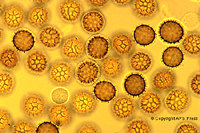Marie A. C. Langham
South Dakota State University
Fresh corn on the cob picked on a warm summer day and served steaming hot with melting butter is one of summer’s top highlights. Those gleaming ears of corn are a great source of pride for farmers and home gardeners who avidly grow them. Imagine their dismay and horror when their corn begins to swell with large gray growths (Fig. 1). These growths are a sign of corn smut, a familiar plant disease to many farmers and home gardeners.
Corn smut is caused by the Basidiomycete fungus, Ustilago maydis. The “smutty” black powder in the galls is actually composed of millions of teliospores. After the gray membrane or peridium that surrounds the smut gall breaks, these thick-walled diploid spores drop to the soil where they survive throughout the winter. In the spring, the teliospores germinate and form basidia. Here, meiosis (reduction division) occurs to produce the haploid basidiospores, also called sporidia. Basidiospores are splashed or carried by air to young corn seedlings where they germinate to form a hypha. Only when two haploid hypha of compatible types fuse and produce dikaryotic (cells with two haploid nuclei) hyphae does the infection become established, causing the hypertrophy (abnormal cell enlargement) and hyperplasia (increased cell number) associated with this disease. Although galls are principally associated with the ears, they may also appear on the tassel, in the stalk, or on the leaves. As it first develops, the gall is a solid grayish white mass of combined fungal mycelium and corn tissue, but soon the tissue differentiates into the distinctive dark “smutty” teliospores that begin the yearly cycle again.
However, not everyone who has corn smut in their garden or field is disappointed. Many people in Central America and some people in the United States are excited to find corn smut. They know corn smut as “huitlacoche” or “cuitlacoche”. Huitlacoche is a prized food in Central America where it is used in soups, enchiladas, tortillas, and many other dishes. It also can be found as a canned product at the grocery store. The taste has been described by different people as being mushroom-like, sweet, savory, woody, earthy, smoky corn-like, or inky. Not all these descriptions sound appealing, but corn smut does have high levels of the flavor compounds, sotolon and vanillin, with high levels of glucose. In the US, many epicureans have encouraged people to try corn smut, and it can be found on the menus of many trendy restaurants where it is often called Mexican truffle, maize mushroom, caviar Azteca, or Mexican caviar.
Fresh ears of corn with well developed smut have been priced at $12-$15 per pound, and the canned huitlacoche that typically holds the smut from three to four ears of corn sells for approximately $13.00. These prices are much higher than the prices for healthy ears of corn, which has encouraged some farmers to reconsider their opinion of corn smut. This unique, but growing, market has resulted in some farmers to trying to grow corn smut. In Central America, farmers often cut young corn plants to encourage infection by corn smut, and in the US, some farmers have been using the inoculation methods used by corn smut researchers to increase the infection in their corn. Thus, corn smut is truly a paradox, a pathogen that some people work to eliminate and a gourmet food to others. It is a pathogen that causes yield losses and destruction to some and increased profit to others. In the end, each person must decide for themselves how they view corn smut, but one question that remains at the end of our corn smut story is “Would you invite this pathogen to dinner?”.
For more information on corn smut, try these websites:
 |
Views: Bunts are a type of smut in small grains caused by the fungal genus, Tilletia, and are related to corn smut. The thick walled teliospores from Tilletia controversa will also survive the winter in the soil and initiate the bunt disease cycle in the spring. Click image for an enlarged view and more information.
|
